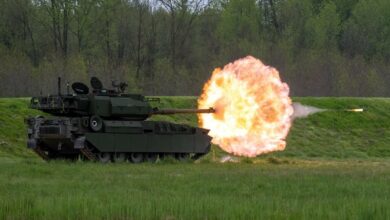US to send ‘additional military assets’ to Syria’s oil region amid troop withdrawal
Announcement sows confusion over the remains of Washington's Syria policy
The U.S. Defense Department said that it planned to increase up its presence in eastern Syria – amidst a wider troop drawdown following Turkey’s attack on the Syrian Democratic Forces – in order to protect oil fields from being retaken by Islamic State.
“One of the most significant gains by the US and our partners in the fight against ISIS was gaining control of oil fields in Eastern Syria – a crucial source of revenue for ISIS,” a defense official said in a Thursday, October 24 statement.
The U.S. and SDF captured the last remaining ISIS territory in eastern Syria in March, though sleeper cells remain.
“The U.S. is committed to reinforcing our position, in coordination with our SDF partners, in northeast Syria with additional military assets to prevent those oil fields from falling back to into the hands of ISIS or other destabilizing actors,” the official said, on grounds of anonymity.
“We must deny ISIS this revenue stream to ensure there’s no resurgence.”
The announcement came a day after Newsweek cited a single Pentagon source as mentioning plans to deploy units from U.S. Army armored brigade combat team (ABCT) battalion to eastern Syria to secure oil fields.
The U.S. and SDF control a number of lucrative but severely damaged oilfield facilities along the northeast side of the Euphrates river near the Iraq border in Deir Ezzor province.
 The pumping facilities sustained heavy bombardment by the U.S.-led Coalition against ISIS, aiming to disrupt the group’s revenue streams.
The pumping facilities sustained heavy bombardment by the U.S.-led Coalition against ISIS, aiming to disrupt the group’s revenue streams.
The U.S. is withdrawing most of its forces from Syria following President Donald Trump’s announcement last week that all American troops would leave the country’s north, where they had served as a buffer between the Kurdish-led SDF, government forces and forces backed by Turkey until Ankara launched an incursion against the SDF on October 9.
But in a reversal on Wednesday, Trump said a few U.S. troops would be staying behind to protect oil fields.
“We have secured the oil and, therefore, a small number of U.S. troops will remain in the area where they have the oil,” Trump said, raising speculation as to whether the president’s advisors had echoed a campaign promise to “take the oil” in the Middle East to give cover to the military’s force protection concerns amidst a drawdown.
Pro-Syrian regime forces, backed by Russian and Iranian military advisors, maintain a presence across the Euphrates river from the oilfields and have attempted to seize at least one U.S. and SDF-held position in the area before.
Following the U.S. withdrawal announcement, the Russian government said last week that Damascus should restore its control all of Syria’s oil assets.
There remains a significant U.S. military presence at and around al-Omar oilfield, Syria’s largest, which lies across from the city of al-Mayadin, as well as a base at the Conoco gas facility northeast of Deir Ezzor city.
Syrian regime and Russian military assets moved on the Conoco gas facility in February 2018 before being repulsed by heavy U.S. air and artillery strikes in an incident that left hundreds dead and was quietly downplayed by both sides.
Pro-regime forces still maintain a small foothold on the east side of the Euphrates near the village of Khasham, just south of the Conoco gas facility.
Coalition aircraft have destroyed pontoon bridges to prevent pro-regime units from crossing the Euphrates near the oilfields in the past, SDF officials have told The Defense Post.
A Manbij Military Council commander who had fought against ISIS on the Deir Ezzor front in December told The Defense Post at the time that U.S. military officials had committed then to defend the strategic territory “as long as they are there.”
Esper said on Sunday that the removal of American forces to western Iraq would make place over “weeks,” not days, but American troops have left Syria en masse over the last week. On Sunday, a CJTF-OIR spokesperson told The Defense Post that troops had pulled out of installations in and around Manbij, Raqqa, Tabqa and the Lafarge Cement Factory.
“We’ll work something out with the Kurds so that they have some money, so that they have some cash flow. Maybe we’ll get one of our big oil companies to go in and do it properly,” Trump said at a Cabinet meeting on Monday.
An office connected to the predominately-Kurdish People’s Protection Units (YPG), which forms the core of the SDF, manages the small amounts of crude extracted from the area’s wells, according to documents previously provided to The Defense Post.
In an interview with The Defense Post in Washington on Monday, Ilham Ahmed, the executive president of the SDF’s political wing, said it is “not moral” for U.S. troops to remain in Syria only to guard oil wells and not stop Turkey’s incursion.
If U.S. troops are to stay in northeast Syria, she said, “it’s only moral for the sake of the 5 million people in danger there.”
This week, SDF commander Mazlum Abdi said trust for the U.S. was “at its lowest” after the White House ordered American troops to get out of the way of a Turkish attack that has cost hundreds of lives and displaced more than 170,000 people in the northeast.
With reporting from AFP












